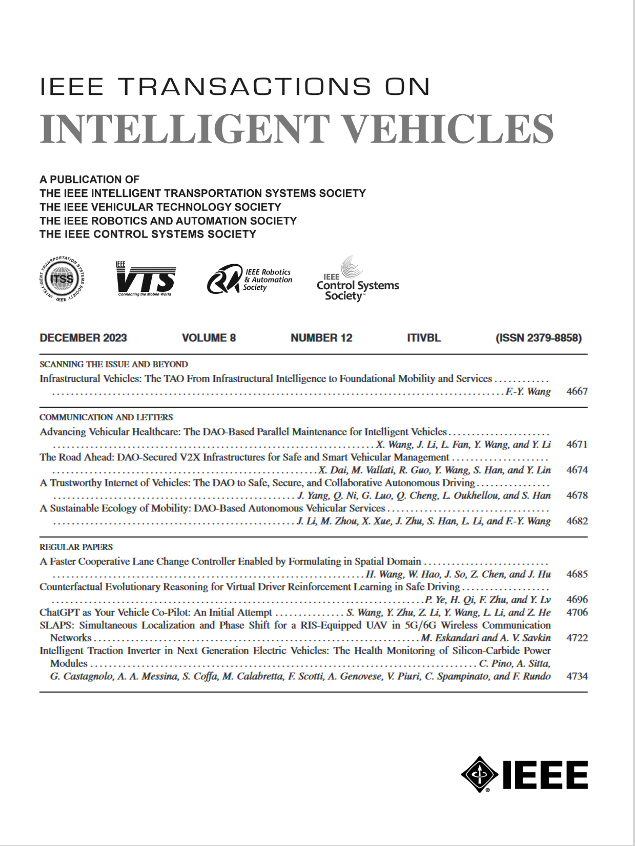无人机在复杂地形环境下跟踪失踪目标的搜索区域预测算法
IF 14.3
1区 工程技术
Q1 COMPUTER SCIENCE, ARTIFICIAL INTELLIGENCE
引用次数: 0
摘要
提出了一种新的动态目标搜索区域预测(SAP)算法,以解决在复杂地形环境下失踪车辆的跟踪问题。该算法旨在提高目标丢失后的预测效果。首先,建立了基于物理规则的目标运动预测模型;该模型能准确预测动态目标的潜在运动模式。随后,将基于规则的模型用于最大熵深度逆强化学习(MEDIRL)算法的专家演示。利用目标的真实轨迹数据对软行为者-批评家(Soft Actor-Critic, SAC)算法得到的网络结构模型进行微调。这一步可以快速拟合当前目标的驱动意图和偏好。此外,该算法预测目标位置的分布,并生成基于概率的热图,反映目标在地形上存在的可能性。为了确定目标存在概率最大的区域,采用了空间滑动自适应窗口(SSAW)方法。该方法可以根据热图动态调整区域,重点关注最可能出现目标的区域。仿真结果表明,该算法能够有效地预测目标区域,并且具有较高的包含目标的概率。这些预测结果为山地地形环境下的目标跟踪提供了有价值的参考。本文章由计算机程序翻译,如有差异,请以英文原文为准。
Search Area Prediction Algorithm for Tracking Missing Target in Complex Terrain Environments Using UAVs
This paper presents a novel dynamic-target search area prediction (SAP) algorithm to address the challenge of tracking missing vehicles lost in complex terrain environments. The algorithm aims to improve the effectiveness of prediction after target loss. First, a target motion prediction model based on physical rules is established. This model can accurately predict the potential movement patterns of the dynamic targets. Subsequently, the rule-based model is used as expert demonstrations in the Maximum Entropy Deep Inverse Reinforcement Learning (MEDIRL) algorithm. And the real trajectory data of the target will be used to fine-tune the network structure model obtained by Soft Actor-Critic (SAC) algorithm. This step can quickly fit the driving intentions and preferences of the current target. Furthermore, the algorithm predicts the distribution of target positions and generates a probability-based heatmap, reflecting the likelihood of target presence across the terrain. To determine the area containing the highest probability of target, a spatial sliding adaptive window (SSAW) method is employed. This approach can dynamically adjust the area based on the heatmap, focusing on the most probable region for target presence. Simulation results demonstrate that the proposed algorithm effectively predicts target areas with a higher probability of containing the targets. These predictions provide valuable reference for target tracking in mountainous terrain environments.
求助全文
通过发布文献求助,成功后即可免费获取论文全文。
去求助
来源期刊

IEEE Transactions on Intelligent Vehicles
Mathematics-Control and Optimization
CiteScore
12.10
自引率
13.40%
发文量
177
期刊介绍:
The IEEE Transactions on Intelligent Vehicles (T-IV) is a premier platform for publishing peer-reviewed articles that present innovative research concepts, application results, significant theoretical findings, and application case studies in the field of intelligent vehicles. With a particular emphasis on automated vehicles within roadway environments, T-IV aims to raise awareness of pressing research and application challenges.
Our focus is on providing critical information to the intelligent vehicle community, serving as a dissemination vehicle for IEEE ITS Society members and others interested in learning about the state-of-the-art developments and progress in research and applications related to intelligent vehicles. Join us in advancing knowledge and innovation in this dynamic field.
 求助内容:
求助内容: 应助结果提醒方式:
应助结果提醒方式:


